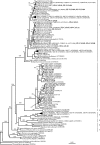Molecular diversity of methanogens in feedlot cattle from Ontario and Prince Edward Island, Canada
- PMID: 17483285
- PMCID: PMC1932772
- DOI: 10.1128/AEM.00103-07
Molecular diversity of methanogens in feedlot cattle from Ontario and Prince Edward Island, Canada
Abstract
The molecular diversity of rumen methanogens in feedlot cattle and the composition of the methanogen populations in these animals from two geographic locations were investigated using 16S rRNA gene libraries prepared from pooled PCR products from 10 animals in Ontario (127 clones) and 10 animals from Prince Edward Island (114 clones). A total of 241 clones were examined, with Methanobrevibacter ruminantium accounting for more than one-third (85 clones) of the clones identified. From these 241 clones, 23 different 16S rRNA phylotypes were identified. Feedlot cattle from Ontario, which were fed a corn-based diet, revealed 11 phylotypes (38 clones) not found in feedlot cattle from Prince Edward Island, whereas the Prince Edward Island cattle, which were fed potato by-products as a finishing diet, had 7 phylotypes (42 clones) not found in cattle from Ontario. Five sequences, representing the remaining 161 clones (67% of the clones), were common in both herds. Of the 23 different sequences, 10 sequences (136 clones) were 89.8 to 100% similar to those from cultivated methanogens belonging to the orders Methanobacteriales, Methanomicrobiales, and Methanosarcinales, and the remaining 13 sequences (105 clones) were 74.1 to 75.8% similar to those from Thermoplasma volcanium and Thermoplasma acidophilum. Overall, nine possible new species were identified from the two clone libraries, including two new species belonging to the order Methanobacteriales and a new genus/species within the order Methanosarcinales. From the present survey, it is difficult to conclude whether the geographical isolation between these two herds or differences between the two finishing diets directly influenced community structure in the rumen. Further studies are warranted to properly assess the differences between these two finishing diets.
Figures

References
-
- Beauchemin, K. A., and S. M. McGinn. 2005. Methane emissions from feedlot cattle fed barley or corn diets. J. Anim. Sci. 83:653-661. - PubMed
-
- de Rijk, P., and R. de Wachter. 1993. DCSE, an interactive tool for sequence alignment and secondary structure research. Comput. Applic. Biol. Sci. 9:735-740. - PubMed
-
- Environment Canada. 2004. Canada's greenhouse gas inventory 1990-2000. Government of Canada EPS 5 /AP/ 8. Environment Canada, Ottawa, Canada.
-
- Felsenstein, J. 1985. Confidence limits on phylogenies: an approach using the bootstrap. Evolution 39:783-791. - PubMed
-
- Felsenstein, J. 2004. PHYLIP (Phylogeny Inference Package) documentation files, version 3.62c. Department of Genetics, University of Washington, Seattle.
MeSH terms
Substances
Associated data
- Actions
- Actions
- Actions
- Actions
- Actions
- Actions
- Actions
- Actions
- Actions
- Actions
- Actions
- Actions
- Actions
- Actions
- Actions
- Actions
- Actions
- Actions
- Actions
- Actions
- Actions
- Actions
- Actions
- Actions
- Actions
- Actions
- Actions
- Actions
LinkOut - more resources
Full Text Sources
Molecular Biology Databases

